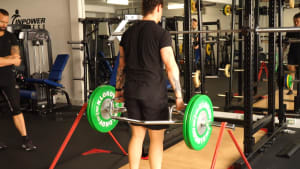
Personal Training for Strength
Functional hypertrophy is one of the most misunderstood coaching terms in modern strength training. When athletes, for example, come across the term they tend to think of muscle builders like Arnold Schwarzenegger winning another Mr. Olympia by hitting a double biceps or hulking out by Lou Ferrigno as a superhero. However, it is actually a lot more complicated than that. From a point of view, functional hypertrophy can be an ideal way to get the fastest results possible for a client
Functional hypertrophy can be defined as strategic muscle growth to improve physical performance. The Webster dictionary defines it as "excessive development of a part or organ" and an "increase in bulk (as in thickening of muscle fibers) without multiplication of that part".
Hypertrophy training involves the performance of resistance exercises that build muscles. The difference comes in when the word "functional" is added to the equation as this type of hypertrophy exercise involves improving body composition and strengthening certain parts of the body to perform specific tasks.
For a personal trainer considering programming for functional hypertrophy, functional hypertrophy involves training that is both heavy and fast to make running and jumping more explosive without the person gaining too much body weight.
Beyond Muscle
While mechanical loading in weight training triggers processes in the muscle and cell fibers of the body that lead to protein synthesis resulting in muscle growth, it is a misconception that increased muscle mass improves performance. For example, in competitive bodybuilding growing muscles is what it's all about, however, most bodybuilders with impressive physiques are not as strong as they look. It all comes down to the type of muscle fibers that are being trained: fast or slow twitch.
Fast-twitch muscle fibers (also known as Type II fibers) produce high levels of force but low levels of endurance. In this group we find sprinters, gymnasts, and weightlifters;
Slow-twitch fibers (also known as Type I fibers) produce low levels of force but high levels of endurance - here we think of long-distance runners, cyclists, and also bodybuilders.
It may sound strange that competitive bodybuilders and distance runners can have the same types of muscle fiber, but bear in mind that there are several different subcategories in each fiber type. As a result, a bodybuilder who trains with higher reps will have more Type I fibers than for example a weightlifter or a 100-meter sprinter. This is due to a process referred to as the 'Size Principle of Muscle Fiber Recruitment' in which Type II fibers are recruited only after Type I fibers have been recruited. This means that for slow movements or when lifting light weights Type I fibers will primarily be recruited and hypertrophied but when lifting heavier weights or when performing explosive movements, more Type II fibers will primarily be recruited and hypertrophied.
The basis of functional hypertrophy is training that focuses on the recruitment of Type II fibers to produce the greatest increase in strength and power.
According to science, individual muscle fibers are made up of 2 primary components - sarcoplasm and sarcomere. Growing the sarcoplasm component involves an increase in the non-contractile protein and fluids that exist between the muscle fibers. This causes a cross-sectional area of the muscle to become larger while its density is smaller. That is why bodybuilders who focus on sarcoplasmic hypertrophy training have impressive physiques but their relative strength per unit of body weight is low. The type of hypertrophy created by using bodybuilding methods often does not improve athletic performance. The great four-time Olympic weightlifting medalist, Norbert Schemansky once reportedly joked in an interview with Strength and Health Magazine that bodybuilders try to look good while weightlifters try to do good.
Sacomere hypertrophy is what we are talking about when we refer to Functional Hypertrophy. It involves increasing the functional units of the myofibril muscles. An increase in the density of a muscle increases its strength - more specifically its relative strength.
Now let's look at a few real-life examples in sports:
In Rugby league, a winger needs to move as fast as possible. Because any excess body weight, whether fat or muscle mass, will decrease speed, strength training must be focused on the athlete becoming stronger with minimal gain in body weight
In contrast picture the physique of a Forward that needs the same explosive movements as a winger but requires considerably more muscle mass to withstand tackles.
Both will benefit from functional hypertrophy training but at different levels.
Funtional Hypertrophy for the General Population and personal trainers
For the general population who are not particularly interested in competitive sports or building imposing physiques, functional hypertrophy can provide other benefits such as:
- improving body composition
- avoiding injuries
- supporting healthy metabolism
- performing daily tasks more easily
It would make sense that a personal trainer should use these to improve someone life. Functional hypertrophy training is especially important for ageing individuals who are more susceptible to losing strength as they grow older. Strength is what enables them to maintain their stability and prevent falls.
Functional Hypertrophy for Athletes
A major concern for any athlete who needs to accelerate and run fast is hamstring injuries. Type II fibers in hamstring muscles are responsible for speed as they respond better to high-intensity contractions. Weight training involving heavy weights with relatively low reps is required to improve speed and acceleration. Whereas an Olympic bodybuilder like Ronnie Coleman reportedly had a functional hypertrophy protocol involving sets of leg curls with 8 - 12 reps, a sprinter would benefit more by performing sets of 3 - 5 reps to maximize muscle growth. However, considering that an inverse relationship exists between sets and reps, a sprinter would need to perform more sets of 3 - 5 reps to achieve the same hypertrophy effects as a bodybuilder performing sets of 8 - 12 reps for maximal muscle growth.
Functional hypertrophy is the way to go for endurance athletes because of the additional burden that excess muscle mass can place on the cardiovascular system. There is even a benefit for marathon runners performing resistance training to avoid the muscle-degrading effects of aerobic training. However, for peak performance, it is not necessary for them to squat with double bodyweight.
A favorite protocol of mine as a personal trainer involves giant sets performing 4 or more exercises for each body part. These giant sets produce a robust, anabolic hormone response through stimulation of growth hormone and an insulin-like growth factor 1 release. A giant set for the lower body may include eccentric-enhanced squats, elevated heel squats, lunges, and hex bar or trap bar deadlifts.
All athletes need to regularly hit the gym, however, they must ensure that they train with a purpose. Functional hypertrophy training is the optimal type of muscle training for athletes and personal trainers who need strength, speed, and endurance.




